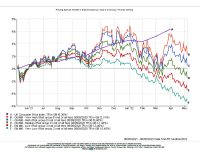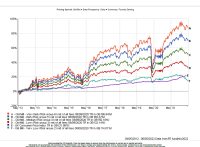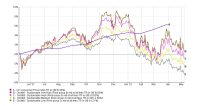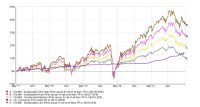Performance of the Old Mill Portfolios
The beginning of 2022 continues to be challenging with pressure on defensive assets from rising interest rates alongside volatile stock markets fuelled by the situation in Ukraine.
We have discussed before that many of you may refer to the status of the FTSE100 index as a barometer for portfolio performance given it is so widely quoted on various media channels.
Looking at short term performance it may seem that on occasions the FTSE100 index is rising when your portfolio, overall, is falling. The reason for this is due to a number of factors:
12th May 2022
While the UK stock market has performed much better than many other stock markets since the beginning of the year, equity performance globally has generally declined.
The very first point to make is that the UK equity content of the Medium risk portfolio for example is about 10%, so it’s no surprise that your portfolio does not precisely follow the movements of the FTSE100.
The biggest equity component of a medium risk portfolio is the US which makes up a little over 20%. Unfortunately, this more growth-orientated index has suffered in the short term because of a shift in market sentiment towards “value” stocks and away from “growth” stocks which have, in the previous few years, been the driver of sharp market movements upwards.
The UK market has benefited in the short term because it has more of these value stocks, such as energy companies and banks. Portfolio values have benefitted from the UK exposure and also the global value stocks allocation you hold.
Other equity regions have also fallen – Europe, due to the ongoing War in Ukraine, and more recently Emerging Markets, especially China as COVID has caused more lockdowns.
Traditionally, during these spells of equity market weakness, one might rely on the defensive, fixed interest part of portfolios for some stability. As we discussed earlier, whilst these are typically uncorrelated with equities, at this moment in time with rising inflation and interest rates they have also seen falls albeit fairly modest.
The graph below shows the change in value of our portfolios over the year to Friday 1 April 2022:
Core Portfolio Performance over the last year
While the portfolio returns to the end of last year were positive, inflation concerns in December led to sharp falls in growth stocks at the beginning of 2022, exacerbated by the invasion of Ukraine by Russia in February.
Core Portfolio Performance over last ten years
Investing is a long-term pursuit as we so often say and when we look at a longer period of time you can see a comfortable margin of return over inflation, other than the very low risk group.
Sustainable Portfolio Performance over the last year
Strong growth in 2021 was derailed at the start of 2022. Only the very High Risk portfolio saw gains over the year, with falls in value for lower risk portfolios. Sustainable portfolios saw greater pressure than our standard portfolios in the first couple of months of the year with a greater exposure to US stock markets that fell in the face of rising interest rates.
Sustainable Portfolio Performance over five years
Over the longer time frame of five years (as the sustainable strategy has not yet been managed for ten years) you can see stronger inflation plus returns although the Low Risk portfolio has just dipped under inflation recently.
Below shows the performance of a number of asset classes in April and over the last year as at close of play on Wednesday 4 May.
While some growth assets have seen good returns over the year, the position in April was of a broad based fall in all assets.





